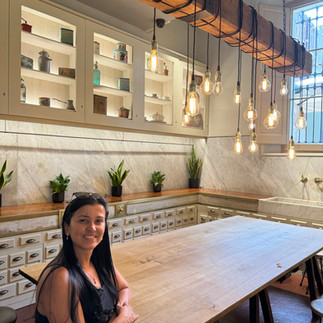Barcelona Moments: Art, Architecture & Soulful Connections
- Ms. Mila Vasconcelos

- Oct 1
- 3 min read
Barcelona Moments: Art, Architecture & Soulful Connections
World Curriculum - by Ms. Mila Vasconcelos

In the summer of 2024, I arrived in Barcelona unsure of what to expect. After recent news reports of conflicts between tourists and locals, I questioned whether my visit would be peaceful or overwhelming. But just like travel often teaches us, real experiences begin when we open ourselves to conversations and connections.
That’s exactly what happened when I met up with a former Catalan student of mine, who once joined my art classes during an exchange program in the USA. We
met at La Boqueria market, and over fresh fruit and churros, he explained the real impact of tourism on daily life in Barcelona. He told me how certain neighborhoods feel like stage sets now, and how the identity of the Catalan people can often feel lost in the crowds. After our chat, we left the noise behind and walked through the more tranquil Plaça de Catalunya, where the city’s real rhythm could still be felt.
And yet, as a passionate visual artist, I couldn’t miss Antoni Gaudí’s masterpieces—sacred, surreal, and deeply human.
La Sagrada Família: A Dream in Progress
The Sagrada Família is unlike anything I’ve ever seen. Gaudí called this basilica his act of devotion to God—and you feel that. As I entered, light from the kaleidoscopic vitrals wrapped around me like a spiritual hug. I stood still, overwhelmed by the harmony of geometry, color, and silence. It’s not only the biggest Catholic church still under construction (expected to finish in 2033!), but one of the most personal projects ever undertaken in art history. Gaudí died tragically in 1926, struck by a tram, never seeing his dream complete—but the world has kept building for him.
Parc Güell: Architecture That Grows From the Earth
After leaving the basilica, I took a long, beautiful walk to Parc Güell, the original site of a failed housing development that became one of the most poetic architectural spaces on Earth. Gaudí lived in a house inside the park, monitoring Sagrada’s construction from afar.

The curved benches, mosaic tiles, and dragon fountain all play together in a visual symphony—one that feels like it emerged from nature itself. This is where Gaudí’s organic forms come alive, showing us that structure and freedom can coexist in perfect balance.
Casa Batlló & Casa Milà: Where Imagination Found a Home
Another highlight of this trip was reuniting with a dear Brazilian friend I met earlier in the summer during my visit to Cleopatra’s Pool and Pamukkale in Turkey (a story for another blog post!). She lives in Spain now, and it was such a joy to explore Gaudí’s homes together—hearing her local insights, recommendations, and understanding of the Spanish way of life.
Casa Batlló and Casa Milà (La Pedrera) are full of curves, flowing tiles, surreal balconies, and rooftops that feel like sculpture gardens. Every corner is personal. Gaudí didn’t build just for functionality—he created environments that made you feel. His sense of identity is in every mosaic, windowpane, and carved handrail. That’s what inspired me most: the idea that we can imprint our artistic voice in everything we do.
A Legacy That Lives Through Us
Gaudí spent his entire life in service of one massive dream—and yet never saw it complete. But he planted the seed of an artistic language so distinctive, so full of truth, that it continues to grow. For me, this trip wasn’t just about ticking boxes on a travel itinerary. It was about learning from someone who gave everything to art and spirituality, and realizing that when we create with honesty and soul, the world responds—even if it takes decades.
This journey reminded me of the kind of artist, teacher, and global citizen I want to be. And that, to me, is worth more than any postcard!
Ms. Mila Vasconcelos

































































































Comments